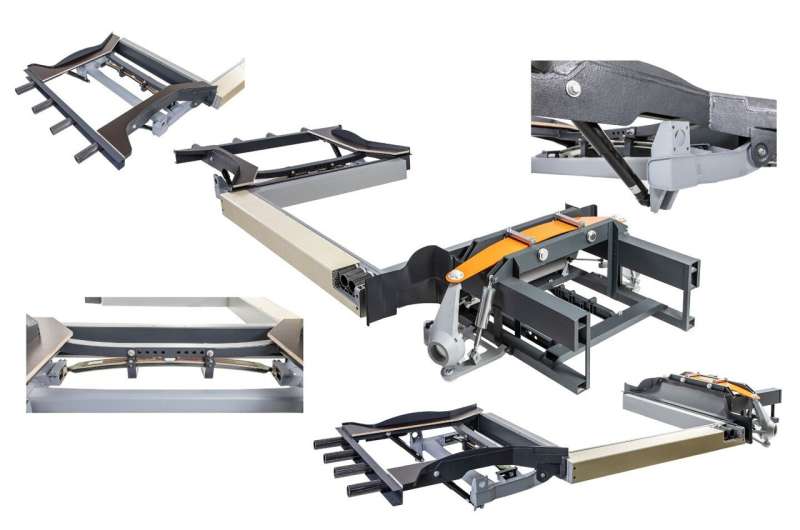Reusable open source design kit for electrically powered shared vehicles

Manufacturing automobiles requires energy and resources on a large scale. Higher vehicle mileage could result in a significant drop in the continuous energy demand during production, while also reducing the extraction of natural resources considerably.
This is where the KOSEL research project comes in; a project that has seen the Fraunhofer Institute for Machine Tools and Forming Technology IWU join forces with partners from industry and research: Vehicle components that have a long service life can be used over several vehicle life cycles and therefore do not need to be produced anew. With this in mind, the project team has developed a closed-loop open-source modular system that consists of particularly durable and reusable modules.
Within the KOSEL framework, the project team has developed the basic concept for a lightweight electric commercial vehicle with a total permissible weight of 3.5 metric tons, the components of which are entirely modular. The three main modules—front end, battery box and rear end—are connected to each other via fixed interfaces, meaning that replacement work can be carried out very easily.
“With this closed-loop modular system, it is possible to replace individual or complete vehicle components. Consequently, the bulk of the vehicle components will have a longer service life. Repair costs are reduced, and the vehicle can be run economically for longer,” explains Patryk Nossol, a researcher in the Systems and Technologies for Textile Structures (STEX) department at Fraunhofer IWU in Zittau, Germany.
The electric vehicle platform has been designed and prototyped for service lives of up to 30 years and mileages of up to one million kilometers in varying deployment scenarios.
Durable modules made from carbon fiber-reinforced plastics
The material concept provides for the use of durable materials predominantly in the sections that are subject to high stress and intended for repeated reuse. Carbon fiber-reinforced plastics (CFRP) are best suited for this purpose.
“Admittedly, these materials have a comparatively high CO2 footprint in production. However, when used correctly, they make up for this through their low mass and, not least, their extraordinary fatigue strength over long periods of use. CFRP is the preferred alternative when these hidden assemblies are used over more than one life cycle, as they are in this concept,” Nossol explains.
Carbon fiber-reinforced plastic is best suited for use in the sill area due to its durability. “In this area, the absorbers, which are made of CFRP tubes, are arranged at different angles in order to protect against different impact angles. For better replaceability, we arranged the absorbers in modules and installed them in pot-shaped receptacles,” says Nossol.
New crash absorber design ensures safety
Passenger safety is of paramount importance when it comes to vehicle design. For this reason, a wide range of crash scenarios are simulated, tested and analyzed in order to deduce suitable safety measures from the data collected. “Fortunately, in real life, passengers very rarely find themselves in these critical situations. That’s why crash absorbers are particularly well-suited to reuse,” Nossol explains.
Drawing on his preliminary studies at Fraunhofer IWU, Nossol developed the concept of a new type of sill that is capable of withstanding oblique impacts. This sill is based on a specific crash-effect principle: the inversion of CFRP crash tubes, the special way these tubes are positioned within the sill and the introduction of force via auxetic structures.
“Auxetic structures are unusual in that they contract transversely to the direction of compression,” Nossol explains.
“The individual elements work together in the event of a crash. The sill absorbs the load and transfers it to an auxetic structure made of polyurethane. This results in orthogonal compression, i.e., compression transverse to the direction of the load, meaning that the force is introduced into the crash tubes gradually and the vehicle is decelerated as desired through controlled failure of the composite material. The aim is to create as many small fiber breaks as possible, each requiring a high level of energy, which ultimately causes the vehicle to decelerate,” explains Nossol, who points out that the intact CFRP crash tubes can also be reused in new vehicle models or generations following an accident or when a vehicle comes to the end of its service life.
“Either in the same part of the vehicle or another part, like the rear section, after it has been cut to size. What’s more, we can absorb up to four times as much energy by weight with these fiber composite tubes as with aluminum. Conversely, this means the crash absorber can absorb the same amount of energy despite being about four times lighter.”
Environmentally friendly concept for the future
The recyclable KOSEL mobility concept is intended for fleet vehicles with a middling number of units. The precondition is a circular value chain that allows for inspection and, if necessary, rework of individual components after the first life cycle. The concept is intended to serve as a model and spark other similar developments in the mobility industry.
Most notably, having a fully developed, closed-loop electric vehicle platform as a standard solution can reduce development costs and risks. The open-source interfaces will also make it appealing for suppliers to offer suitable standard components.
More information:
The KOSEL project: innovative-produktkreislaeufe. … /Projects/KOSEL.html
Citation:
Reusable open source design kit for electrically powered shared vehicles (2023, April 3)
retrieved 3 April 2023
from https://techxplore.com/news/2023-04-reusable-source-kit-electrically-powered.html
This document is subject to copyright. Apart from any fair dealing for the purpose of private study or research, no
part may be reproduced without the written permission. The content is provided for information purposes only.
For all the latest Technology News Click Here
For the latest news and updates, follow us on Google News.
